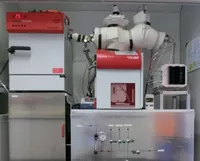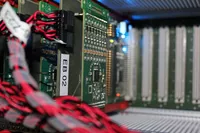Chair of Technical Electrochemistry (TEC), Prof. Dr. Hubert Gasteiger
In the field of cell diagnostics, the Chair of Technical Electrochemistry is extensively involved with the gassing of lithium-ion batteries, which can be measured and quantified potential-resolved by means of a self-designed measurement set-up (OEMS). Further in-situ characterisation methods are impedance spectroscopy (resistance measurement) and XRD measurements (change in the structure of the active materials) of a running lithium-ion cell.
Chair of Digital Catalysis, Prof. Dr. Helge Stein
In the field of Cell Diagnostics, our research involves investigating both commercial and self-assembled cells using a variety of cycling and formation strategies, as well as experimenting with different temperatures. Additionally, we aim to uncover how material properties, along with parameters in electrode manufacturing, can affect cell behavior, thereby contributing to a deeper understanding of both material and cell dynamics.
Chair of Automotive Technology, Prof. Dr.-Ing. Markus Lienkamp
Our service portfolio in (cell) diagnostics includes the development and testing of thermal and electrical test benches precisely tailored to the requirements of modern battery systems. Additionally, we conduct Hardware-in-the-Loop (HiL) tests to evaluate BMS functions, such as fast-charging procedures or operational strategies under realistic conditions. For a thorough assessment of battery lifespan, we analyze cell aging characteristics and specifically investigate phenomena like Thermal Runaway (TR) and Thermal Propagation (TP). Another focus is on researching online EIS applications and diagnostic charging procedures for electric vehicles, aimed at continuously monitoring and optimizing battery health during operation.
Chair of Electrical Energy Storage Technology, Prof. Dr.-Ing. Andreas Jossen
In the field of cell diagnostics, the focus is on the safe and reliable operation of lithium-ion cells. The topics covered range from ageing and state of charge determination, sensors and evaluation electronics for batteries to cell balancing systems. The aim is to optimise the various functionalities of a battery management system.
TUM-ZWE at the research neutron source (FRM II), Gruppe Advanced Materials, Dr. habil. Ralph Gilles
Neutron radiation is often particularly well suited for the analysis of cells. Neutrons also make it possible, for example, to track or detect neighbouring elements of the periodic table or light elements such as lithium next to heavy elements. Concentration profiles of lithium, structural changes or lithium deposition (lithium plating) can also be detected.








